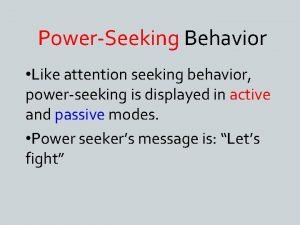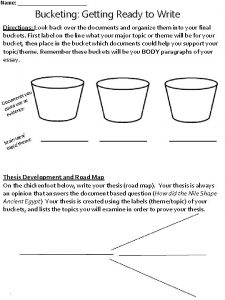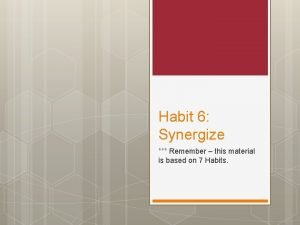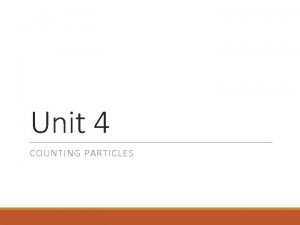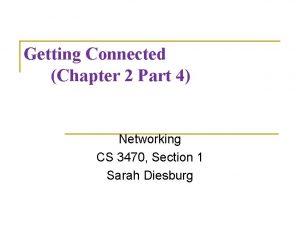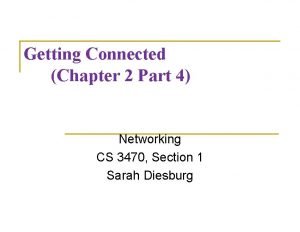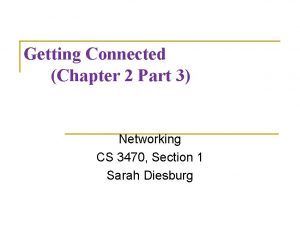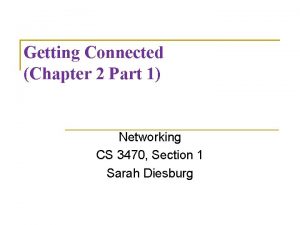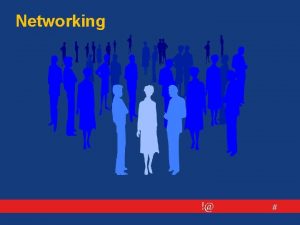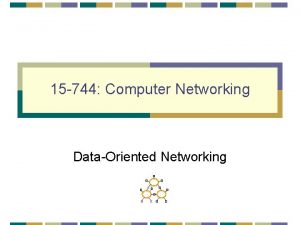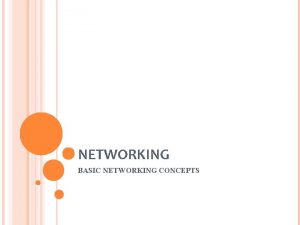Getting Connected Chapter 2 Part 3 Networking CS

































- Slides: 33

Getting Connected (Chapter 2 Part 3) Networking CS 3470, Section 1 Sarah Diesburg

Last Lectures Encoding/decoding Framing Error Detection

Today Error Correction (through reliability mechanisms Media Access

Reliability Three sample problems A frame has corrupt (and non-recoverable) data. What do you do? Your store-and-forward switch is being flooded by connections and your input buffer is full. What do you do? You are a transmitting process that requires a guaranteed delivery. How long do you “hold out” before assuming a packet was lost?

Reliability Usually accomplished through combination of two fundamental mechanisms Acknowledgments (ACKs) Timeouts 5

ARQ General strategy of using ACKs and timeouts to implement reliable delivery is called automatic repeat request (ARQ) Stop-and-wait Sliding window 6

Stop-and-Wait Simplest algorithm After transmitting one frame, sender waits for ACK before transmitting next frame If ACK does not arrive in time, sender times out and retransmits original frame 4 basic scenarios What are they? 7

Stop-and-Wait Timeline diagram The ACK is received before the timer expires

Stop-and-Wait The original frame is lost 9

Stop-and-Wait The ACK is lost 10

Stop-and-Wait ACK not delivered before timeout How to fix? ? 11

Stop-and-Wait Suppose sender ends up sending duplicate frames and receiver got both frames E. g. , if ACK from receiver was lost or timed out Q: How does receiver know that it shouldn’t use both frames? 12

Stop-and-Wait Is 1 bit enough? Timeline for stop-and-wait with 1 -bit sequence number

Delay x Bandwidth Again… Represents the amount of data that could be in transit Would like to be able to send this much data without waiting for the first acknowledgment “Keeping the pipe full”

Stop-and-Wait Does not “keep the pipe full” Consider a 1. 5 Mbps link with a 45 ms RTT and a 1 KB frame size To use the link fully, then sender should transmit up to eight frames before having to wait for an acknowledgement How? ? ?

Stop-and-Wait The link has a delay bandwidth product of 67. 5 Kb or approximately 8 KB Since the sender can send only one frame per RTT and assuming a frame size of 1 KB Maximum Sending rate is about 1/8 of link’s capacity 16

Sliding window time transition time 1 RTT ACK Sender Receiver

Sliding Window The sliding window requires a more elaborate sequence number: Send window size: SWS Last frame sent: LFS Last frame ACK'd: LAR (last ACK rec'd) SWS ≥ LFS - LAR After a while, you can't send any more frames until ACKs start coming back. Note: Packets may be delivered out of sequence!

Sliding Window After a while, the sender can't send any more frames until ACKs start coming back Window is “full” Note: Packets may be delivered out of sequence! 19

Sliding Window Pkt 0 sent 0 1 2 3 4 5 6 Nothing yet received 0 1 2 3 4 5 6

Sliding Window Pkt 0 sent 0 1 2 3 4 5 6 Pkt 0 rcvd, Ack 0 sent 0 1 2 3 4 5 6

Sliding Window Pkt 0 sent 0 1 2 3 4 5 6 Pkt 0 rcvd, Ack 0 sent 0 1 2 3 4 5 6

Sliding Window Pkt 0 sent 0 1 2 3 4 5 6 Pkt 1 sent 0 1 2 3 4 5 6 Pkt 0 rcvd, Ack 0 sent 0 1 2 3 4 5 6 X

Sliding Window Pkt 0 sent 0 1 2 3 4 5 6 Pkt 1 sent 0 1 2 3 4 5 6 Pkt 2 sent, window full 0 1 2 3 4 5 6 Pkt 0 rcvd, Ack 0 sent 0 1 2 3 4 5 6 X Pkt 2 rcvd, buffered 0 1 2 3 4 5 6

Sliding Window Pkt 0 sent 0 1 2 3 4 5 6 Pkt 1 sent 0 1 2 3 4 5 6 Pkt 2 sent, window full 0 1 2 3 4 5 6 Pkt 0 rcvd, Ack 0 sent 0 1 2 3 4 5 6 X Pkt 2 rcvd, buffered 0 1 2 3 4 5 6 Receiver doesn’t send ACK for 2 because of cumulative ACKS. (ACK’ing high number implies all previous frames have already been ACK’ed)

Sliding Window Pkt 0 sent 0 1 2 3 4 5 6 Pkt 1 sent 0 1 2 3 4 5 6 Pkt 2 sent, window full 0 1 2 3 4 5 6 Ack 0 rcvd, Pkt 3 sent 0 1 2 3 4 5 6 Pkt 0 rcvd, Ack 0 sent 0 1 2 3 4 5 6 X Pkt 2 rcvd, buffered 0 1 2 3 4 5 6 Pkt 3 rcvd, buffered 0 1 2 3 4 5 6

Sliding Window Pkt 0 sent 0 1 2 3 4 5 6 Pkt 1 sent 0 1 2 3 4 5 6 Pkt 0 rcvd, Ack 0 sent 0 1 2 3 4 5 6 X Pkt 2 sent, window full 0 1 2 3 4 5 6 Ack 0 rcvd, Pkt 3 sent 0 1 2 3 4 5 6 Pkt 1 timeout, Pkt 1 resent 0 1 2 3 4 5 6. . . Pkt 2 rcvd, buffered 0 1 2 3 4 5 6 Pkt 3 rcvd, buffered 0 1 2 3 4 5 6 Waiting… 0 1 2 3 4 5 6

Sliding Window Pkt 0 sent 0 1 2 3 4 5 6 Pkt 1 sent 0 1 2 3 4 5 6 Pkt 0 rcvd, Ack 0 sent 0 1 2 3 4 5 6 X Pkt 2 sent, window full 0 1 2 3 4 5 6 Ack 0 rcvd, Pkt 3 sent 0 1 2 3 4 5 6 Pkt 1 timeout, Pkt 1 resent 0 1 2 3 4 5 6. . . Pkt 2 rcvd, buffered 0 1 2 3 4 5 6 Pkt 3 rcvd, buffered 0 1 2 3 4 5 6 Pkt 1 rcvd, Ack 3 sent 0 1 2 3 4 5 6

Sliding Window Quiz Pkt 8 sent, window full 0 1 2 3 4 5 6 7 8 9 10 What is the SWS? (Send Window Size) Last frame sent: LFS? Last frame ACK'd: LAR? 29

Sliding Window Quiz Pkt 8 rcvd, Ack 8 sent 0 1 2 3 4 5 6 7 8 9 10 Receive window size: RWS? Last frame received: LFR? Largest acceptable frame: LAF? 30

Sliding Window There are “issues” with the sliding window protocol with regard to the window size and the sequence number. Suppose window size is one less than total sequence numbers and ACKs are dropped In the end: SWS < (Max. Seq. Num+1)/2 Alternates between two halves of the sequence number space

Sliding Window SWS Problem Pkt 0 sent 0 1 2 Pkt 1 sent 0 1 2 Timeout, resend 0 0 1 2 Pkt 0 rcvd, Ack 0 sent 0 1 2 X X Pkt 1 rcvd, Ack 1 sent 0 1 2 Which pkt 0 are we receiving? Version 1, or version 2?

Sliding Window Benefits Reliable delivery of frames Preservation of order at the receiver end Flow control “Throttles the sender” Reliable delivery of frames important at the link layer (remember, ISO/OSI model) The other two are sometimes better implemented at higher layers
 The secret to getting ahead is getting started
The secret to getting ahead is getting started Sdn vs traditional network
Sdn vs traditional network Lesson 20 getting connected ionic compounds
Lesson 20 getting connected ionic compounds Wye delta diagram
Wye delta diagram In a triangle connected source feeding
In a triangle connected source feeding In a triangle connected source feeding a y connected load
In a triangle connected source feeding a y connected load Chapter 5 lesson 4 getting help
Chapter 5 lesson 4 getting help Chapter 5 lesson 4 getting help answer key
Chapter 5 lesson 4 getting help answer key Chapter 4 section 1: ecosystems: everything is connected
Chapter 4 section 1: ecosystems: everything is connected Part whole model subtraction
Part whole model subtraction Part to part ratio definition
Part to part ratio definition Part part whole
Part part whole Technical object description example
Technical object description example Parts of the bar drawing
Parts of the bar drawing The phase of the moon you see depends on ______.
The phase of the moon you see depends on ______. 미니탭 gage r&r 해석
미니탭 gage r&r 해석 Blue and yellow make
Blue and yellow make Unit 2 getting acquainted with the vehicle
Unit 2 getting acquainted with the vehicle If a student driver commits a traffic violation
If a student driver commits a traffic violation Analysis of the story fur coat
Analysis of the story fur coat Scienstructable
Scienstructable Is uv getting stronger
Is uv getting stronger Getting organizational redesign right
Getting organizational redesign right Revenge seeking behavior
Revenge seeking behavior Why does curley wear a vaseline-filled glove on one hand?
Why does curley wear a vaseline-filled glove on one hand? Bucketing getting ready to write
Bucketing getting ready to write Management is an art of getting things done
Management is an art of getting things done Habit 6 synergy
Habit 6 synergy Getting started with vivado
Getting started with vivado Getting started with unix
Getting started with unix Splunk elearning
Splunk elearning Rancher slack
Rancher slack Getting started with excel
Getting started with excel Counting by weighing
Counting by weighing























